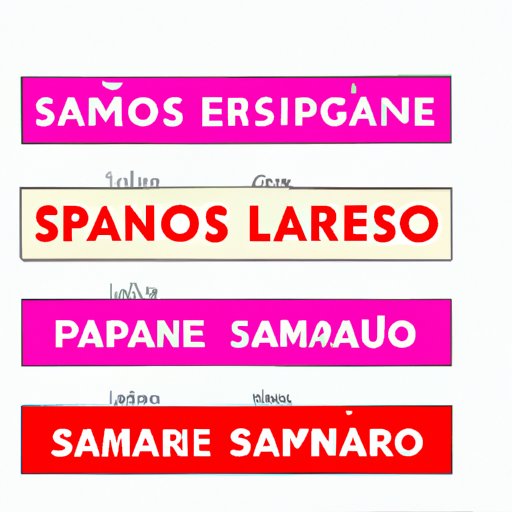
Introduction
Learning a new language can be an intimidating task, but it can also be one of the most rewarding experiences one could have. Whether you want to communicate with Spanish-speaking individuals or travel to a Spanish-speaking country, knowing how to say things in Spanish is a valuable skill to have. In this article, we’ll go over the essential tips and tricks for mastering Spanish, from the basics of common phrases to the complexities of verb conjugation and sentence structure.
The Ultimate Beginner’s Guide to Spanish: How to Say Common Phrases
Before diving into the intricate details of the Spanish language, it’s essential to learn the basics of everyday conversation. In this section, we’ll cover common phrases used in Spanish, including how to say hello, introduce yourself, order food, and more. Here are some examples of how to say these phrases in Spanish:
- Hello – Hola (oh-lah)
- Goodbye – Adiós (ah-dee-ohs)
- Excuse me – Con permiso (cone pair-mee-so)
- Thank you – Gracias (grah-see-us)
- Please – Por favor (pour fah-vore)
- My name is… – Me llamo… (may yah-moh)
- How are you? – ¿Cómo estás? (coh-moh ess-tahs)
- Where is…? – ¿Dónde está…? (dohn-deh ess-tah)
- I don’t understand – No entiendo (noh en-tee-en-doh)
- Can you help me? – ¿Puedes ayudarme? (pweh-dess ah-yoo-dar-meh)
Speak Spanish Like a Pro: Mastering How to Say Things in Spanish
Once you have a good grasp of common phrases used in everyday conversation, it’s time to focus on improving your overall Spanish speaking skills. Here are a few tips for improving your Spanish pronunciation and fluency:
- Listen to Spanish music, podcasts, and TV shows
- Practice speaking with native speakers or language tutors
- Use language learning apps and resources
It’s crucial to avoid some common pitfalls when trying to sound like a native Spanish speaker. One of the most significant challenges for learners is correctly rolling their “rr” sounds, which can be challenging to master. Avoiding direct translations from English to Spanish is another vital step in sounding like a native speaker. Spanish sentences often use different grammatical structures than English.
Say What? A Simple Guide on How to Pronounce Spanish Words
The Spanish language has a phonetic association between letters and sounds, which means that once you know the different vowel and consonant sounds, it becomes easier to read, write, and pronounce words. Here is an explanation of basic Spanish pronunciation rules:
- Vowels: In Spanish, there are five vowel sounds, A, E, I, O, and U, with each letter pronounced consistently. For example, the letter “a” always sounds like “ah,” while “e” sounds like “eh.”
- Consonants: Most Spanish consonant sounds are the same as in English, although there are a few exceptions. For example, the letter “c” has two different sounds, depending on whether it directly precedes the letters “e” or “i.” In this case, it sounds like “th” in thick.
Hola and Adios: How to Say Greetings and Farewells in Spanish
Greetings and farewells are an essential part of social interactions. In this section, we’ll cover different ways to say hello and goodbye in Spanish:
- Good morning – Buenos días (bway-nos dee-ahs)
- Good afternoon – Buenas tardes (bway-nahs tar-dehs)
- Good evening – Buenas noches (bway-nahs noh-chess)
- See you soon – Hasta pronto (ah-stah prohn-toh)
- See you later – Hasta luego (ah-stah loo-eh-go)
- Take care – Cuídate (kwee-dah-teh)
Breaking the Language Barrier: How to Say Basic Spanish Words and Phrases
Knowing basic vocabulary can help you communicate in Spanish more efficiently. Whether you travel to Spanish-speaking countries or just want to converse with Spanish speakers, here are some key terms to know:
- Hello – Hola (oh-lah)
- Goodbye – Adiós (ah-dee-ohs)
- Yes – Sí (see)
- No – No (noh)
- Water – Agua (ah-gwah)
- Food – Comida (coh-mee-dah)
- Money – Dinero (dee-neh-ro)
- Bathroom – Baño (bah-nyoh)
- Hotel – Hotel (oh-tel)
- Help – Ayuda (ah-yoo-dah)
Essential Vocabulary: How to Say Numbers, Colors, and Days of the Week in Spanish
Numbers, colors, and days of the week are essential words to know in any language. Here are some examples of how to say these words in Spanish:
- Number one – uno (oo-noh)
- Number two – dos (dohs)
- Number three – tres (trehs)
- Color red – rojo (roh-hoh)
- Color blue – azul (ah-sool)
- Color green – verde (vair-day)
- Monday – lunes (loo-ness)
- Tuesday – martes (mar-tess)
- Wednesday – miércoles (mee-ehr-koh-les)
- Thursday – jueves (hoo-eh-bays)
Conquer the Spanish Language: How to Master Verbs and Sentence Structure
Verb conjugation and sentence structure are two of the most challenging aspects of learning Spanish. Here are some tips for mastering these concepts:
- Learn the different verb tenses
- Practice conjugating verbs
- Understand sentence structure rules
Here are some examples of basic sentence structures in Spanish:
- I am hungry – Tengo hambre (ten-goh ham-bray)
- You are from Spain – Eres de España (air-ess day espan-ya)
- He is a doctor – Él es un médico (el ess oon may-dee-co)
- She speaks Spanish – Ella habla español (ay-yah ah-blah ess-pan-yol)
Conclusion
Learning how to say things in Spanish can be an enjoyable experience that helps you connect with new people and cultures. By following this guide, you can master the Spanish language from its basic phrases to its complex grammar and sentence structures. Remember to practice consistently and surround yourself with the language to achieve fluency.




